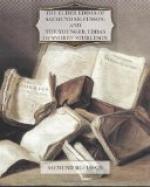As introductory to the Voluspa, the following description of a wandering Vala or prophetess may be thought both desirable and interesting: “We find them present at the birth of children, when they seem to represent the Norns. They acquired their knowledge either by means of seid, during the night, while all others in the house were sleeping, and uttered their oracles in the morning; or they received sudden inspirations during the singing of certain songs appropriate to the purpose, without which the sorcery could not perfectly succeed. These seid-women were common over all the North. When invited by the master of a family, they appeared in a peculiar costume, sometimes with a considerable number of followers, e.g. with fifteen young men and fifteen girls. For their soothsaying they received money, gold rings, and other precious things. Sometimes it was necessary to compel them to prophesy. An old description of such a Vala, who went from guild to guild telling fortunes, will give the best idea of these women and their proceedings":—
“Thorbiorg, nicknamed the little Vala, during the winter attended the guilds, at the invitation of those who desired to know their fate, or the quality of the coming year. Everything was prepared in the most sumptuous manner for her reception. There was an elevated seat, on which lay a cushion stuffed with feathers. A man was sent to meet her. She came in the evening dressed in a blue mantle fastened with thongs and set with stones down to the lap; round her neck she had a necklace of glass beads, on her head a hood of black lambskin lined with white catskin; in her hand a staff, the head of which was mounted with brass and ornamented with stones; round her body she wore a girdle of agaric (knoske), from which hung a bag containing her conjuring apparatus; on her feet were rough calfskin shoes with long ties and tin buttons, on her hands catskin gloves, white and hairy within. All bade her welcome with a reverent salutation; the master himself conducted her by the hand to her seat. She undertook no prophecy on the first day, but would first pass a night there. In the evening of the following day she ascended her elevated seat, caused the women to place themselves round her, and desired them to sing certain songs, which they did in a strong, clear voice. She then prophesied of the coming year, and afterwards, all that would advanced and asked her such questions as they thought proper, to which they received plain answers.”
* * * * *
In the following grand and ancient lay, dating most probably from the time of heathenism, are set forth, as the utterances of a Vala, or wandering prophetess, as above described, the story of the creation of the world from chaos, of the origin of the giants, the gods, the dwarfs, and the human race, together with other events relating to the mythology of the North, and ending with the destruction of the gods and the world, and their renewal.




